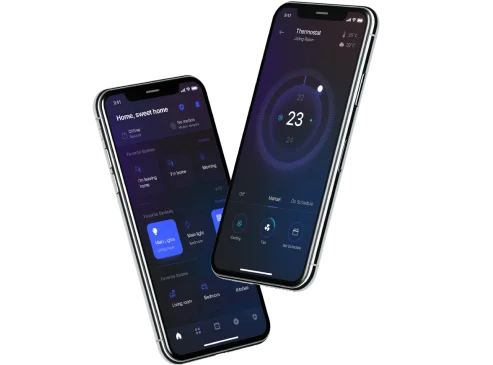Penetration testing services
-
Get a practical assessment of your product’s security posture and the effectiveness of your security measures by simulating real-world hacking
-
Meet regulatory and security standards by successfully passing comprehensive penetration testing
-
Stay confident during mergers and acquisitions with our M&A Due Diligence services that include penetration testing, business architecture assessments, and DevOps security reviews
-
Launch new products confidently with our custom application security assessment, safeguarding your reputation and customers’ trust from day one
Value we have delivered to our clients
-
300+
secure solutions delivered
-
ISO
27001- and 27701-compliant products and services
-
20+
GDPR-compliant solutions
-
6
security operation centers (SOCs)
Your journey with Yalantis
-
01
Have an initial consultation and define the scope of testing.
Discuss your specific objectives and the scope of penetration testing activities you are looking for.
-
02
Receive and approve a custom proposal.
Based on the initial assessment results, you will receive a detailed proposal outlining the scope, methodology, timeline, and cost of penetration testing services. Once you approve the proposal, we can formalize the agreement.
-
03
Conduct penetration testing.
Your product will be tested by the Yalantis team according to the agreed scope and methodology. We’ll simulate real-world cyberattacks to identify vulnerabilities in your product or infrastructure.
-
04
Receive and analyze reports.
Upon completion of the testing phase, you will receive reports that include an executive summary communicating the results of testing and your security posture in non-technical language and a technical chapter detailing vulnerabilities discovered, their severity levels, and recommended remediation steps.
-
05
Get remediation support and follow-up testing.
You will receive assistance from Yalantis experts in addressing identified vulnerabilities if you don’t have your own resources to deal with them. We’ll guide you through implementing remediation measures to strengthen your cybersecurity posture. Following testing, we’ll hold discussions to ensure all concerns are effectively addressed and provide guidance for future security enhancements.
Pen testing services offered by Yalantis
Yalantis is a penetration testing service provider that offers a comprehensive suite of services, from network infrastructure evaluation to social engineering training and source code review:
-
Network infrastructure testing
-
External network penetration testing
-
Internal network penetration testing
-
-
Web application testing
-
API security assessment
-
Web app security evaluation using OWASP top 10 assessment criteria
-
Business logic review
-
Source code review
-
Dependency analysis
-
-
Cloud penetration testing
-
Cloud misconfiguration detection
-
Exposed sensitive interface detection
-
Leaked credentials check
-
Cloud architecture assessment
-
Cloud infrastructure configuration review
-
Data encryption and key management review
-
Serverless architecture security review
-
IaaC analysis
-
-
Social engineering
-
Phishing simulation campaign
-
Vishing (voice phishing) assessment
-
Social engineering simulation
-
-
Mobile security testing
-
Web app business logic review
-
Mobile application penetration testing
-
Mobile app security evaluation using OWASP top 10 assessment criteria
-
Security controls testing
-
Mobile app source code review
-
Mobile device configuration review
-
BUILD RESILIENT BUSINESS INFRASTRUCTURE AND PROTECT YOURSELF AGAINST CYBER THREATS
Yalantis specialists will help you augment your organization with additional cybersecurity protection, safeguard sensitive data, and spread awareness among your employees
Yalantis solutions that have included pen testing service as part of the development cycle
EMBED SECURITY BEST PRACTICES AT EACH STAGE OF THE SOFTWARE DEVELOPMENT LIFE CYCLE
Consult the Yalantis cybersecurity team on the best ways to ensure resilience against cyberattacks from project idea to implementation
Insights from Yalantis

DevOps Accelerator enabling 4X faster infrastructure deployment
Deploy your infrastructure four times faster with the Yalantis DevOps Accelerator and substantially facilitate your platform’s development and public release.

Robotic process automation in banking: improve and speed up your operational management
Read about robotic process automation in the banking sector. We provide insights on how to ensure automation in banking operations by implementing a ready-made or custom banking automation system.

A Complete Guide to Data Modeling with Examples
Learn what data modeling is and why building accurate data models is important for software development success. Get to know why as a C-level executive you should participate in the data modeling process.
FAQ
Why do you need penetration testing service?
Penetration testing services are essential for identifying vulnerabilities in your systems, applications, and network infrastructure. By simulating real-world attack scenarios, these services help you understand your security weaknesses and take proactive measures to allow your system to deflect any online threats.
More importantly, regular pentest services are often required for regulatory compliance and can provide peace of mind as you can know that your organization’s assets are thoroughly evaluated by cybersecurity experts.
Can penetration test services disrupt the work process?
While there may be temporary disruptions during testing, such as network slowdowns or brief service interruptions, reputable penetration testing companies strive to minimize these impacts and schedule testing during off-peak hours whenever possible.
Prior coordination and communication with your team can help mitigate any potential disruptions, and the benefits of performing thorough pentesting usually outweigh any temporary inconveniences.
Are pentesting services sufficient to protect my business against cyberattacks?
Penetration testing services are a crucial component of a robust cybersecurity strategy. However, they are not sufficient on their own to fully protect your business against cyberattacks.
Penetration testing helps identify vulnerabilities, but it’s essential to complement it with other security measures such as regular security assessments, patch management, employee training, network monitoring, and robust security controls.
STAY AHEAD OF EVOLVING CYBERSECURITY THREATS
Partner with Yalantis to be prepared and easily deflect cyberattacks, protect sensitive data, and ensure compliance with industry standards
What can you expect from our penetration testing company services?
Yalantis follows a structured approach to deliver expert pentesting services without any disruptions. It consists of the following stages:
Stage #1 Pre-engagement
Yalantis cybersecurity specialists start by identifying a client’s objectives, scope, and specific requirements for penetration test service. This involves:
- interviewing stakeholders to clarify goals, target systems, and any constraints or limitations
- addressing all necessary legal and compliance requirements, such as obtaining authorization to perform testing and adhering to relevant regulations and standards
Stage #2 Reconnaissance
Next, our pen test company collects information about target systems with active and passive reconnaissance processes to define the most likely attack vectors.
Active reconnaissance includes gathering information about the infrastructure and product, which can be useful in identifying the attack surface and potential entry points. We gather the following information:
- IP addresses
- domain names
- related information
Passive reconnaissance is focused on using OSINT techniques to gather additional information about the target product without directly interacting with it. Types of information collected include:
- leaked data
- publicly available documents
- social media profiles
This helps to tailor attack vectors and improve testing effectiveness.
Stage #3 Vulnerability assessment
Once necessary information is gathered, Yalantis security specialists perform an in-depth vulnerability assessment using automated and manual approaches. This includes:
- network scanning
- web application scanning
- database scanning
- reviewing business logic
The purpose of this assessment is to identify potential entry points for exploitation. Scanning also helps in identifying open ports and services, as well as understanding the network topology to determine potential attack vectors.
Stage #4 Exploitation
The exploitation stage involves the pen test services itself. Yalantis experts will attempt to exploit identified vulnerabilities and weaknesses to identify their impact on the product and your business. This includes using techniques such as SQL injection, cross-site scripting (XSS), and remote code execution.
Once a vulnerability is proved, the test engineer simulates actions that a malicious actor might take, such as extracting data (data exfiltration), escalating privileges, and moving laterally within the network. This demonstrates the potential impact of a successful cyberattack on your systems.
Stage #5 Reporting
After conducting tests, Yalantis penetration test company provides you with a detailed technical report that includes a comprehensive analysis of each vulnerability, along with recommended remediation steps and best practices for improving the product’s overall security posture.
You will receive:
- a clear and concise executive summary written in non-technical language that all employees can understand, highlighting key findings, risk exposure, and recommendations
- a detailed report documenting all identified vulnerabilities, exploited weaknesses, and recommendations for remediation
- a security score for each vulnerability, considering factors like exploitability, business impact, and ease of remediation
Stage #6 Post-engagement
During this stage, you engage in a debriefing session with Yalantis experts to discuss findings, answer questions, and provide guidance on remediation efforts. If you require further assistance and ongoing support with remediation, the Yalantis team can assist you in leading those efforts and addressing any additional concerns or questions that arise.
What are the benefits for businesses that choose Yalantis as their penetration testing company?
Choosing Yalantis as your penetration testing services vendor has several benefits for your business:
- Expertise. Yalantis pentest company experts are professionals certified in ethical hacking by OSCP and EC-Counsil and have extensive experience in cybersecurity, ensuring thorough assessments and accurate findings.
- Comprehensive assessments. You will get comprehensive evaluations of your systems, applications, and network infrastructure to identify vulnerabilities and will get actionable recommendations for improvement.
- Real-world simulations. The Yalantis cybersecurity team simulates real-world attack scenarios during penetration test exercises following the best ethical hacking methodologies to assess the effectiveness of your security controls and help you understand potential risks.
- Regulatory compliance. Yalantis is an ISO 27001- and ISO 27701–certified pentesting company. Our services can help you meet regulatory requirements and demonstrate due diligence in protecting sensitive information.
- Continuous improvement. By establishing a cycle of regular testing and continuous improvement, Yalantis experts can assist you in staying ahead of emerging threats and strengthening your defenses over time.
What vulnerabilities can be detected by examining your systems at a pen testing company?
Pentesting services are a proactive approach to identifying security vulnerabilities in a system, application, or network infrastructure. By performing penetration testing, you can uncover a lot of potential weak spots, such as:
- Weak authentication mechanisms. Penetration testers often find weak or default passwords, a lack of multi-factor authentication, or poorly implemented authentication mechanisms that can be exploited to gain unauthorized access to systems or accounts.
- Unpatched software. Failure to install security patches and updates can leave systems vulnerable to known exploits. Pentesting identifies outdated software versions with known vulnerabilities that need to be addressed.
- Insecure network configurations. Misconfigured firewalls, routers, and other network devices can create security gaps that attackers can exploit. Penetration tests assess network configurations for weaknesses that could be exploited to gain unauthorized access or disrupt services.
- Injection flaws. Injection flaws, such as SQL injection and command injection, occur when untrusted data is sent to an interpreter as part of a command or query. Penetration testing identifies areas where input validation is lacking, allowing attackers to manipulate queries and commands.
- Cross-site scripting (XSS). XSS vulnerabilities occur when web applications fail to properly sanitize user input, allowing attackers to inject malicious scripts into web pages. Pen test identifies XSS vulnerabilities that could be used to steal session cookies, deface websites, or perform other malicious actions.
- Sensitive data exposure. Pen tests identify instances where sensitive data is stored or transmitted insecurely. This includes insecure storage, lack of encryption, and improper access controls.
- Security misconfigurations. Misconfigured security settings, resulting in services running unnecessarily or improper access controls, can create opportunities for attackers to exploit. Penetration testing identifies and helps remediate these misconfigurations.
- Insecure direct object references (IDOR). IDOR vulnerabilities occur when an application exposes internal objects to users, allowing them to manipulate data they should not have access to. Penetration testing identifies instances where inadequate access controls could lead to data leakage or unauthorized access.
- Denial of service (DoS) vulnerabilities. Pen testing assesses systems for vulnerabilities that could be exploited to perform DoS attacks, such as resource exhaustion, improper error handling, or lack of rate limiting.
- Missing or inadequate logging and monitoring. Effective logging and monitoring are essential for detecting and responding to security incidents. Penetration testing assesses the effectiveness of logging and monitoring mechanisms and identifies areas for improvement.
Three approaches to penetration testing services: Finding out how to combine them for the best result
Depending on the weaknesses to be addressed and the depth of organizational information gathered, pentesting services use one of three approaches: black box, gray box, or white box penetration testing. Let’s take a closer look at each of them.
Black box penetration testing
In black box testing, the tester has no prior knowledge of or access to the internal workings of the system being tested. They approach the assessment as an external attacker would, with only publicly available information.
Advantages of black box testing:
- Mimics a real-world scenario where attackers have no insider knowledge
- Provides an unbiased assessment of the organization’s security posture from an external perspective
Disadvantages of black box testing:
- May overlook certain vulnerabilities that require internal knowledge or context
- Takes longer due to the need for reconnaissance and information gathering
Best suited for:
- Testing public-facing systems such as websites, web applications, and network infrastructure
- Assessing the effectiveness of perimeter defenses and identifying vulnerabilities that can be exploited without internal knowledge
- Simulating real-world attack scenarios where the attacker has no insider knowledge
White box penetration testing
White box testing provides the tester with full knowledge of the system’s architecture, source code, and internal configurations. This allows for a comprehensive assessment of all components and potential vulnerabilities.
Advantages of white box testing:
- Allows for a deeper and more thorough assessment, as testers can analyze the system from both external and internal perspectives
- Can uncover vulnerabilities that may be missed in black box testing
Disadvantages of white box testing:
- May not accurately represent the perspective of an external attacker
- Requires cooperation and access from the organization being tested, which may not always be feasible or practical
Best suited for:
- Assessing complex systems, applications with intricate architectures, and environments with strict regulatory compliance requirements
- Businesses looking for a comprehensive assessment of their internal and external security controls, including those with sensitive data or critical infrastructure
Gray box penetration testing
Gray box testing falls between black box and white box testing. Testers have limited knowledge of the system, typically including some high-level details or credentials, but not full access or deep internal knowledge.
Advantages of gray box testing:
- Strikes a balance between realism and comprehensiveness
- Allows the organization to focus on any areas of concern while still simulating an external attacker’s perspective
Disadvantages of gray box testing:
- May not provide the depth of analysis achievable with white box testing.
- Requires coordination between the testing team and the organization to ensure that the limited information provided is relevant and realistic
Best suited for:
- Businesses that want to focus on specific areas of concern while still simulating an attacker’s perspective
- Testing scenarios where some level of insider access is plausible or where certain information can be provided to enhance testing effectiveness
For optimal results and comprehensive coverage, pen testing experts recommend to conduct penetration testing in multiple stages, beginning with black box testing, followed by gray box testing, and concluding with white box testing. This approach ensures a thorough evaluation of the system’s security by leveraging the varying levels of knowledge and access associated with each testing phase.



